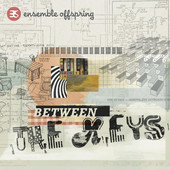Dedicated to new music and new ideas in music performance, Ensemble Offspring has produced a recording of most unusual compositions, based around a new tuning system.

Various composers have collaborated with instrument makers to achieve their objectives in the creation of this new musical vocabulary. The CD booklet helps to explain, via a short historical glance, the difference between Equal Temperament, Just Temperament, and the newly devised Centaur tuning system, which is so important to this new music.
At times though, for the layman, one senses that a degree in applied mathematics or physics might not go astray, in order truly to grasp the numerical intricacies involved.
The greatest proponent of new tuning systems (and consequently the new invention of instruments to which these systems can be applied) is the American microtonal maverick composer and inventor, Harry Partch. Suffice it to say, Partch’s work in this area is enough for its own separate study, and I would recommend his “Genesis of a Music” (1947) should readers be more interested in discovering more deeply about this concept. This recording and performance endeavour, however, is Ensemble Offspring’s own tribute to that philosophy and output of Partch.
On the other hand, one can find appeal in simply listening to the recording as a collection of new music, some of which is inspired by non-Western ideas.
Mysteries by Arana Li utilises the clarinis (a type of new clarinet) and the tarhu (a spike-fiddle like the Middle Eastern Kamancheh) in what is an evocative and meditative dialogue between istruments.
Philip Glass’s Music in Similar Motion is appealing for its repetitive melodic and rhythmic cells.
Amanda Cole’s Hydra (three movement work), based on the Ancient Greek mythology, employs 4 clarinis to enable tunings of major, minor, phrygian and lydian modes to be used.The movements are based solely on the rhythmic and melodic adaption of 4 notes only.
Music and colour are often connected, and in Damien Ricketson’s Some Shade of Blue which uses tarhu and centaur vibraphone, allusions are drawn with the final movement of Messiaen’s Quartet for the End of Time, and.
The pentatonic Akashic Torus by Kraig Grady further enhances one’s interest in eastern philosophy and the diverse patterns found in numbers.
Nuance and colour are the primary elements in Terumi Narushima’s Hidden Sidetracks, with its diverse use of many instruments, and extended performance techniques.
Such works are challenging indeed to our aural senses, but highlight the creativity of these unique performers and composers, as well as the myriad sonic possibilities that can be produced.
Ensemble Offspring is a group of innovative musicians, comprising amongst others, Claire Edwardes, Damien Ricketson, Bree van Reyk, Jason Noble, and Diana Springford, who are joined on this recording by Anna McMichael, Peter Biffin, Kraig Grady and Linsey Pollak. This recording has not been released by one of the major recording labels, but rather those wishing to purchase a copy (or individual tracks) can do so via the website http://www.cdbaby.com/cd/ensembleoffspring2
